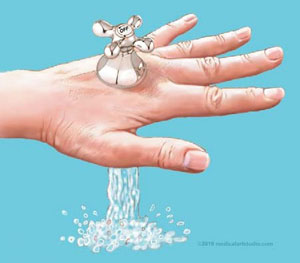Sympathectomy
 Sympathectomy is a type of minimally-invasive procedure (small incisions
of 2–3 inches long, done under general anesthesia) which involves
cauterizing (cutting and sealing) a portion of the sympathetic nerve chain
that runs down the back inside the chest, parallel to the spine.
Sympathectomy is a type of minimally-invasive procedure (small incisions
of 2–3 inches long, done under general anesthesia) which involves
cauterizing (cutting and sealing) a portion of the sympathetic nerve chain
that runs down the back inside the chest, parallel to the spine.
This operation permanently interrupts the nerve signal that is causing the body to sweat excessively.
Sympathectomy is performed to treat a condition known as hyperhidrosis. Hyperhydrosis is a condition characterized by abnormally increased sweating or perspiration in excess of that which is required for regulation of body temperature.
Sympathectomy is also used for facial blushing, some chronic pain conditions and Raynaud’s disease.
After a sympathectomy, the brain can't send signals to the involved areas to make them sweat, blush, or react to the cold as much. This permanent procedure is used as a last resort if other steps, such as antiperspirants or medicines haven't worked.
What to Expect Before Sympathectomy Procedure
To determine whether you need a sympathectomy, your doctor might perform a variety of diagnostic tests, including:
How to Prepare for Sympathectomy Procedure
Prior to the procedure, your doctor and treatment team will explain to you what to expect before, during and after the procedure and potential risks of the procedure. Talk to your doctor about:
- All medications, herbal products and dietary supplements you are currently taking and ask for their recommendations about each.
- Radiation exposure, especially for those that are pregnant.
- Any allergies to medicines, latex, tape, iodine, and anesthetic agents.
- Any history of bleeding disorders.
- Any body piercings on your chest or abdomen.
Other recommendations include:
- Eat a normal meal the evening before the procedure. However, do not eat, drink or chew anything after midnight before your procedure. If you must take medications, only take them with sips of water.
- Leave all jewelry at home.
- Remove all makeup and nail polish.
- Wear comfortable clothing when you come to the hospital.
- If you normally wear dentures, glasses, or hearing devices at home, plan to wear them during the procedure.
What to Expect During Sympathectomy Procedure
The procedure will typically take 1 hour to complete. This procedure is typically performed in the catheterization lab. Check with your doctor about the details of your procedure. In general:
- You will change into a hospital gown.
- A nurse will start the intravenous (IV) line in your arm which will administer medications and fluids during the procedure.
- Usually, your doctor will administer general anesthesia (make you feel sleepy).
- Once you are sedated, your doctor may insert a breathing tube through your throat into your lungs and connect you to a ventilator. This will breathe for you during surgery.
- Your doctor will make 2 to 3 small incisions (cuts) on one side of your chest below your underarm.
- Next, your lung will be temporarily collapsed and moved aside to allow the doctor to reach the nerve chain along your spine.
- Next, the doctor will cut or clamp the nerve chain at the right level, depending on your exact symptoms.
- When finished, the doctor will re-expand the lung, remove all instruments inserted and sew shut the incision.
- Then the doctor will repeat the procedure on your other side.
- Once the overall procedure is complete, you incision(s) will be closed off with the use of stiches or staples, and you will be moved to the recovery area.
What to Expect After Sympathectomy Procedure
After the surgery, you will be taken to a recovery room for further observation. Most people can go home the day after surgery or the day of surgery. Other recommendations include:
General Guidelines
- Your recovery process will vary depending on the type of procedure done and the type of anesthesia that is given. The incision sites will be checked often.
- Once your blood pressure, pulse, and breathing are stable and you are alert, you will be taken to your hospital room.
- Diet is started the day after surgery with liquids, and quickly advanced to solids as tolerated.
- You may feel pain for a week afterward. Your doctor may suggest that you take over-the-counter or prescription pain medicine.
- Ask your doctor how to keep the incisions clean. Avoid soaking in the tub or going swimming for 2 weeks.
- You can probably do your normal activities after the surgery. But, you may need to take it easy at first. No heavy lifting or vigorous exercises until your body has healed.
- Most people can return to work within a week.
